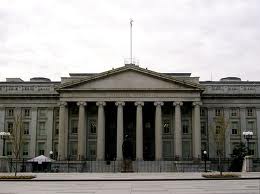 With loan demand still tepid after over five years of unprecedented monetary stimulus by the Federal Reserve, banks need to invest trillions of dollars of deposits that they can’t lend out.
With loan demand still tepid after over five years of unprecedented monetary stimulus by the Federal Reserve, banks need to invest trillions of dollars of deposits that they can’t lend out.
Just as individual savers have been forced to take on more risk and go further out on the yield curve, banks have been forced to do the same. With the net interest margins on loans scrapping all time lows of about 3% for banks with over $100 billion in assets, the lure of going way out on the yield curve becomes irresistible, especially with the current risk free rate of 3.45% on 30 year treasuries.
Banks reaching for yield by investing in long term debt securities become vulnerable to significant losses if interest rates suddenly spike as they did in the early part of last year when the Fed announced they would start “tapering” their quantitative easing program. From the middle of 2012 to year end 2013, banks saw $73 billion in unrealized gains on available-for-sale securities quickly turn into a net unrealized loss of $9 billion. A loss (unrealized) of $82 billion is a significantly adverse event considering that the amount comprises 54% of the entire banking industry’s profits of $154.7 billion for 2013.


Fortunately for the banks, long treasury rates have declined significantly during the first four months of 2014 and banks are again increasing their positions in government debt. Bloomberg reports that Treasuries Irresistible to America’s Banks Awash in Record Cash.
America’s banks are regaining their appetite for U.S. government debt.
After culling Treasuries and bonds issued by federal agencies last year for the first time since 2007, commercial lenders such as Bank of America Corp. (BAC) have boosted their holdings every month this year, Federal Reserve data compiled by Bloomberg show. Banks now own $1.85 trillion of the debt, within 2 percent of the record amount held at the end of 2012.
With a lackluster job recovery and higher mortgage rates damping loan growth, banks are tapping record deposits to plow more money into government debt as regulations designed to limit risk-taking take effect. The demand helps explain why Treasuries are rising from the deepest losses since 2009, confounding forecasters who foresaw declines as a strengthening U.S. economy prompted the Fed to cut back its own bond buying.
Bank of America, the only U.S. bank among the five biggest to publicly release a breakdown of their available-for-sale assets in a supplement to their first-quarter earnings, tripled government debt to $29.6 billion in the first three months of the year from $8.95 billion at the end of 2013, the data show.
Citigroup Inc. (C), the New York-based lender that received a $45 billion bailout during the credit crisis, increased government bonds to $87.6 billion in the fourth quarter from $82.6 billion at the end of the third quarter. The bank had cut the securities in the first three quarters of 2013.
At the same time, consumer lending at U.S. lenders excluding mortgages slowed to a 19-month low in February, while bank deposits exceeded loans by a record $2.49 trillion this month, according to data compiled by Bloomberg.
One reason has been a lack of consistent jobs growth, which had made American households more reluctant to spend.
Have banks suddenly decided to make a massive and risky shift into long dated government debt under the theory that loan demand will remain very slow and interest rates will remain steady or decline further? A look at the most recent data suggests that banks have maintained a relatively conservative and steady course on both the investment amounts and maturity dates of Treasury and federal agency debt holdings.

In addition, banks have increased only slightly the maturity of their long term security holdings.

Banks may have been reckless in the recent past with various lending practices but current portfolio practices regarding investments in U.S. government debt do not seem to be a reason for concern.
Speak Your Mind
You must be logged in to post a comment.